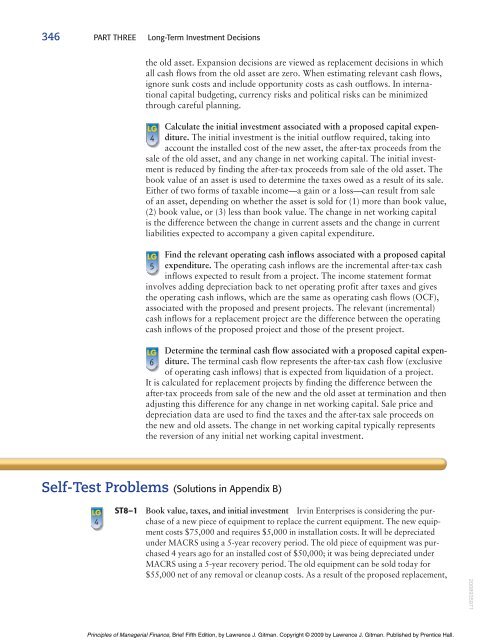Chapter 8 - Pearson Learning Solutions
Chapter 8 - Pearson Learning Solutions
Chapter 8 - Pearson Learning Solutions
You also want an ePaper? Increase the reach of your titles
YUMPU automatically turns print PDFs into web optimized ePapers that Google loves.
346 PART THREE Long-Term Investment Decisionsthe old asset. Expansion decisions are viewed as replacement decisions in whichall cash flows from the old asset are zero. When estimating relevant cash flows,ignore sunk costs and include opportunity costs as cash outflows. In internationalcapital budgeting, currency risks and political risks can be minimizedthrough careful planning.LG4Calculate the initial investment associated with a proposed capital expenditure.The initial investment is the initial outflow required, taking intoaccount the installed cost of the new asset, the after-tax proceeds from thesale of the old asset, and any change in net working capital. The initial investmentis reduced by finding the after-tax proceeds from sale of the old asset. Thebook value of an asset is used to determine the taxes owed as a result of its sale.Either of two forms of taxable income—a gain or a loss—can result from saleof an asset, depending on whether the asset is sold for (1) more than book value,(2) book value, or (3) less than book value. The change in net working capitalis the difference between the change in current assets and the change in currentliabilities expected to accompany a given capital expenditure.LG5Find the relevant operating cash inflows associated with a proposed capitalexpenditure. The operating cash inflows are the incremental after-tax cashinflows expected to result from a project. The income statement formatinvolves adding depreciation back to net operating profit after taxes and givesthe operating cash inflows, which are the same as operating cash flows (OCF),associated with the proposed and present projects. The relevant (incremental)cash inflows for a replacement project are the difference between the operatingcash inflows of the proposed project and those of the present project.LG6Determine the terminal cash flow associated with a proposed capital expenditure.The terminal cash flow represents the after-tax cash flow (exclusiveof operating cash inflows) that is expected from liquidation of a project.It is calculated for replacement projects by finding the difference between theafter-tax proceeds from sale of the new and the old asset at termination and thenadjusting this difference for any change in net working capital. Sale price anddepreciation data are used to find the taxes and the after-tax sale proceeds onthe new and old assets. The change in net working capital typically representsthe reversion of any initial net working capital investment.Self-Test Problems (<strong>Solutions</strong> in Appendix B)LG4ST8–1 Book value, taxes, and initial investment Irvin Enterprises is considering the purchaseof a new piece of equipment to replace the current equipment. The new equipmentcosts $75,000 and requires $5,000 in installation costs. It will be depreciatedunder MACRS using a 5-year recovery period. The old piece of equipment was purchased4 years ago for an installed cost of $50,000; it was being depreciated underMACRS using a 5-year recovery period. The old equipment can be sold today for$55,000 net of any removal or cleanup costs. As a result of the proposed replacement,2008935971Principles of Managerial Finance, Brief Fifth Edition, by Lawrence J. Gitman. Copyright © 2009 by Lawrence J. Gitman. Published by Prentice Hall.

















